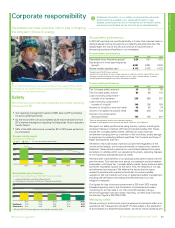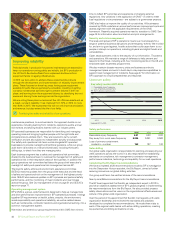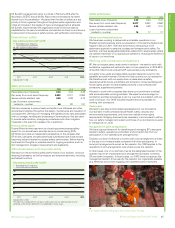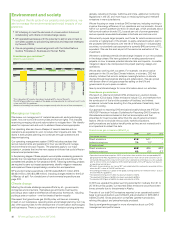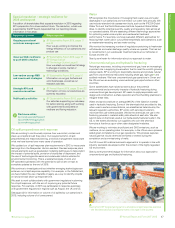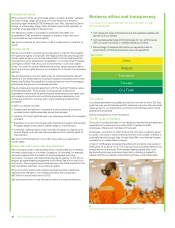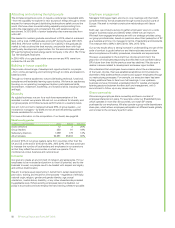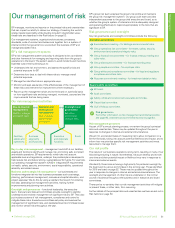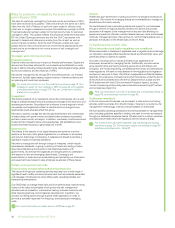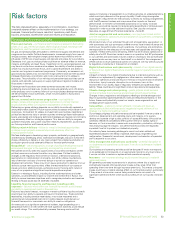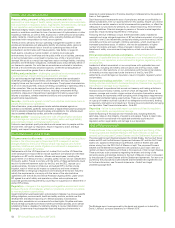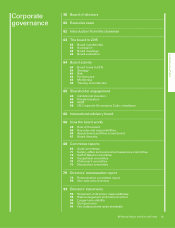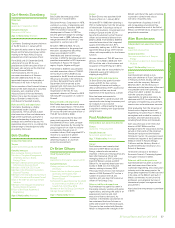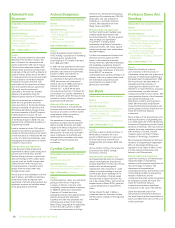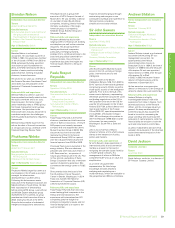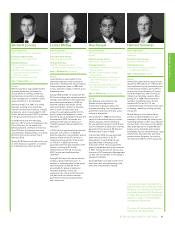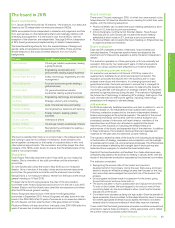BP 2015 Annual Report Download - page 57
Download and view the complete annual report
Please find page 57 of the 2015 BP annual report below. You can navigate through the pages in the report by either clicking on the pages listed below, or by using the keyword search tool below to find specific information within the annual report.
Risk factors
The risks discussed below, separately or in combination, could have
a material adverse effect on the implementation of our strategy, our
business, financial performance, results of operations, cash flows,
liquidity, prospects, shareholder value and returns and reputation.
Strategic and commercial risks
Prices and markets – our financial performance is subject to fluctuating
prices of oil, gas, refined products, technological change, exchange rate
fluctuations, and the general macroeconomic outlook.
Oil, gas and product prices are subject to international supply and demand and
margins can be volatile. Political developments, increased supply from new oil
and gas sources, technological change, global economic conditions and the
influence of OPEC can impact supply and demand and prices for our products.
Decreases in oil, gas or product prices could have an adverse effect on revenue,
margins, profitability and cash flows. If significant or for a prolonged period, we
may have to write down assets and re-assess the viability of certain projects,
which may impact future cash flows, profit, capital expenditure and ability to
maintain our long-term investment programme. Conversely, an increase in oil,
gas and product prices may not improve margin performance as there could be
increased fiscal take, cost inflation and more onerous terms for access to
resources. The profitability of our refining and petrochemicals activities can be
volatile, with periodic over-supply or supply tightness in regional markets and
fluctuations in demand.
Exchange rate fluctuations can create currency exposures and impact
underlying costs and revenues. Crude oil prices are generally set in US dollars,
while products vary in currency. Many of our major project development costs
are denominated in local currencies, which may be subject to fluctuations
against the US dollar.
Access, renewal and reserves progression – our inability to
access, renew and progress upstream resources in a timely manner
could adversely affect our long-term replacement of reserves.
Delivering our group strategy depends on our ability to continually replenish a
strong exploration pipeline of future opportunities to access and produce oil and
natural gas. Competition for access to investment opportunities, heightened
political and economic risks in certain countries where significant hydrocarbon
basins are located and increasing technical challenges and capital commitments
may adversely affect our strategic progress. This, and our ability to progress
upstream resources and sustain long-term reserves replacement, could impact
our future production and financial performance.
Major project★ delivery – failure to invest in the best opportunities
or deliver major projects successfully could adversely affect our
financial performance.
We face challenges in developing major projects, particularly in geographically
and technically challenging areas. Operational challenges and poor investment
choice, efficiency or delivery at any major project that underpins production or
production growth could adversely affect our financial performance.
Geopolitical – we are exposed to a range of political developments and
consequent changes to the operating and regulatory environment.
We operate and may seek new opportunities in countries and regions where
political, economic and social transition may take place. Political instability,
changes to the regulatory environment or taxation, international sanctions,
expropriation or nationalization of property, civil strife, strikes, insurrections,
acts of terrorism and acts of war may disrupt or curtail our operations or
development activities. These may in turn cause production to decline, limit our
ability to pursue new opportunities, affect the recoverability of our assets or
cause us to incur additional costs, particularly due to the long-term nature of
many of our projects and significant capital expenditure required.
Events in or relating to Russia, including further trade restrictions and other
sanctions, could adversely impact our income and investment in Russia. Our
ability to pursue business objectives and to recognize production and reserves
relating to Russia could also be adversely impacted.
Liquidity, financial capacity and financial, including credit,
exposure – failure to work within our financial framework could impact
our ability to operate and result in financial loss.
Failure to accurately forecast, manage or maintain sufficient liquidity and credit
could impact our ability to operate and result in financial loss. Trade and other
receivables, including overdue receivables, may not be recovered and a
substantial and unexpected cash call or funding request could disrupt our
financial framework or overwhelm our ability to meet our obligations.
An event such as a significant operational incident, legal proceedings or a
geopolitical event in an area where we have significant activities, could reduce
our credit ratings. This could potentially increase financing costs and limit
access to financing or engagement in our trading activities on acceptable terms,
which could put pressure on the group’s liquidity. Credit rating downgrades
could trigger a requirement for the company to review its funding arrangements
with the BP pension trustees and may cause other impacts on financial
performance. In the event of extended constraints on our ability to obtain
financing, we could be required to reduce capital expenditure or increase asset
disposals in order to provide additional liquidity. See Liquidity and capital
resources on page 219 and Financial statements – Note 28.
Joint arrangements and contractors – we may have limited control
over the standards, operations and compliance of our partners, contractors
and sub-contractors.
We conduct many of our activities through joint arrangements, associates★ or
with contractors and sub-contractors where we may have limited influence and
control over the performance of such operations. Our partners and contractors
are responsible for the adequacy of the resources and capabilities they bring to
a project. If these are found to be lacking, there may be financial, operational or
safety risks for BP. Should an incident occur in an operation that BP participates
in, our partners and contractors may be unable or unwilling to fully compensate
us against costs we may incur on their behalf or on behalf of the arrangement.
Where we do not have operational control of a venture, we may still be pursued
by regulators or claimants in the event of an incident.
Digital infrastructure and cybersecurity – breach of our digital security
or failure of our digital infrastructure could damage our operations and our
reputation.
A breach or failure of our digital infrastructure due to intentional actions such as
attacks on our cybersecurity, negligence or other reasons, could seriously
disrupt our operations and could result in the loss or misuse of data or sensitive
information, injury to people, disruption to our business, harm to the
environment or our assets, legal or regulatory breaches and potentially legal
liability. These could result in significant costs or reputational consequences.
Climate change and carbon pricing – public policies could increase
costs and reduce future revenue and strategic growth opportunities.
Changes in laws, regulations and obligations relating to climate change could
result in substantial capital expenditure, taxes and reduced profitability. In the
future, these could potentially impact our assets, revenue generation and
strategic growth opportunities.
Competition – inability to remain efficient, innovate and retain an
appropriately skilled workforce could negatively impact delivery of our
strategy in a highly competitive market.
Our strategic progress and performance could be impeded if we are unable to
control our development and operating costs and margins, or to sustain,
develop and operate a high-quality portfolio of assets efficiently. We could be
adversely affected if competitors offer superior terms for access rights or
licences, or if our innovation in areas such as exploration, production, refining or
manufacturing lags the industry. Our performance could also be negatively
impacted if we fail to protect our intellectual property.
Our industry faces increasing challenge to recruit and retain skilled and
experienced people in the fields of science, technology, engineering and
mathematics. Successful recruitment, development and retention of specialist
staff is essential to our plans.
Crisis management and business continuity – potential disruption to
our business and operations could occur if we do not address an incident
effectively.
Our business and operating activities could be disrupted if we do not respond,
or are perceived not to respond, in an appropriate manner to any major crisis or
if we are not able to restore or replace critical operational capacity.
Insurance – our insurance strategy could expose the group to material
uninsured losses.
BP generally purchases insurance only in situations where this is legally and
contractually required. We typically bear losses as they arise rather than
spreading them over time through insurance premiums. This means uninsured
losses could have a material adverse effect on our financial position, particularly
if they arise at a time when we are facing material costs as a result of a
significant operational event which could put pressure on our liquidity and cash
flows.
★ Defined on page 256.BP Annual Report and Form 20-F 2015 53
Strategic report


